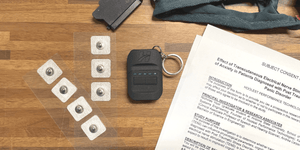Auricular Vagus Nerve Stimulation Demonstrated to be Safe and Well Tolerated
Auricular vagus nerve stimulation has been demonstrated to be safe and well tolerated in thousands of independent human trials.

Safe and Well Tolerated in Thousands
In over 18,000 sessions of transcutaneous electrical nerve stimulation in healthy, neurologically ill, and psychologically ill patients, no serious side effects were reported (source).
In over 6,000 participants who used auricular vagus nerve stimulation for up to 60 minutes at a time, there was no additional risk of experiencing a side effect between those who received real stimulation vs. fake stimulation (source).
In over 1,300 participants, a minimum of 10 minutes of auricular vagus nerve stimulation showed the most common side effects were mild skin discomfort or an uncomfortable “tingliness” (18%) and headache (3.6%) (source).
In over 150 participants, there was no additional risk in experiencing a side effect between those who used the real VeRelief device and those who used a placebo (fake) VeRelief device (source).
VeRelief Technology is Safe and Effective
VeRelief’s underlying auricular vagus nerve stimulation technology was demonstrated to be safe and effective in over 150 patients across 3 IRB-approved and placebo-controlled clinical studies and one IRB-approved case study.

STUDY ONE
Dr. Nicholas Hool, Dr. William J. Tyler, Dr. Sarah Wyckoff, and Dr. Taylor Hearn conducted a study aimed at developing a Targeted Neuroplasticity Training (TNT) method to enhance foreign language learning. They focused on optimizing noninvasive vagus nerve stimulation (VNS) techniques that are comfortable and suitable for everyday use in various training environments.
The researchers explored transdermal auricular vagal nerve stimulation (taVNS), which targets nerve fibers in the external ear, as a more comfortable alternative to other methods. They designed biocompatible, hydrogel earbud electrodes for unilateral or bilateral use, and evaluated their safety and efficacy across different frequencies and intensities.
The team also examined the impact of taVNS on autonomic physiology, attention, sensory gating, and plasticity using various measurements, including heart rate, heart rate variability, skin conductance, skin temperature, respiration rate, EEG, and pupillometry.
The study found that the dry, hydrogel earbud electrode design is a safe and effective method for taVNS.
Read the safety and efficacy report for the first prototype study here

STUDY TWO
POPULATION
- 18 competitive golfers during a 150-yard hitting task.
DEVICE AND TREATMENT DURATION
- 10 minutes of vagus and great auricular nerve stimulation on both sides of neck (bilateral stimulation).
RESULTS
- 36% Clinically Significant Reduction (36%) in state-anxiety in active treatment group after single 10-min treatment. Only 18% reduction in placebo group.
- No differences in safety and tolerability between active and placebo treatments (Pain, dizziness, blurred vision, headache, skin itching or irritation).
- Significant increase in quality of feel of each shot in active group only.

Study Three
POPULATION
- 24 patients with self-diagnosed Post Traumatic Stress Disorder and Panic Disorder.
DEVICE AND TREATMENT DURATION VeRelief handheld device,
- 5-minutes of VeRelief treatment on each side of the neck for a 10-minute total treatment time.
RESULTS
- 24% Clinically Significant Reduction in State-Anxiety in active treatment group after single treatment
- 31% Increase in Heart Rate Variability (rMSSD) in active group alone. 0% change in sham group.
- 100% Of Active Users reported treatment to be “Relaxing”. 33% of sham participants found treatment to be relaxing.
- Active participants were 2x more relaxed than sham participants.
- No differences in safety and tolerability between active and sham treatments (Pain, dizziness, blurred vision, headache, skin itching or irritation).
CASE STUDY
Population: Individual 23-year-old male patient living with diagnosed Panic Disorder and Post-Traumatic Stress Disorder
Protocol: Use 2x per day for 8 weeks. After 8 weeks of using the devices, patient was asked to rate each statement as Strongly Agree, Agree, Neutral, Disagree, or Strongly Disagree.

Results
“I feel better after using the device”
- Strongly Agree 63% of the time
- Agree 37% of the time
“I feel better having access to this device in case I have symptoms”
- Strongly Agree 25% of the time
- Agree 75% of the time
“The device helps me relax”
- Strongly Agree 37% of the time
- Agree 63% of the time
“The device decreases the severity of my symptoms”
- Agree 75% of the time
“The device is easy to use”
- Strongly Agree 12.5% of the time
- Agree 75% of the time
Patient Statement: “It has stopped some panic attacks from getting worse and [felt like] I was melting into my bed. Complete mental and physical relaxation.”




